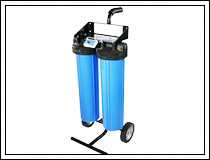De-ionizers
The Process of De-ionization
De-ionization is a frequently used water treatment process which expeditiously removes undesirable salts and minerals from raw water to make it fit for drinkingand industrial purposes. This desalination technique involves passing of water through two ion exchange materials in order to eliminate all sodium, calcium, iron, copper and dissolved anions such as chloride and bromide. Unlike home equipment, de-ionization plants efficiently eliminate all positive metallic ions in the process and supersede them with hydrogen ions instead. When compared to chemical processes or demineralization processes like multiple distillation, de-ionization is extremely simple, user friendly and requires no costly equipment.
 Deionizers/De-ionizing Plants Deionizers/De-ionizing Plants
De-ionizers or de-ionization plants are commercially available as multiple bed and single bed units. Multiple bed units are fabricated with pairs of tanks - one for the cation exchanger, the other for the anion exchanger, while in a single bed unit both the cation and anion exchanger are incorporated in a single tank.
A single bed de-ionizer unit produces higher quality water than the multiple bed or twin bed de-ionizing machine. This is because both the cation and anion exchangers are incorporated in a single tank, which makes it makes them equivalent to a lengthy series of twin bed de-ionizers. But then, although they are superior to and more efficient in producing type 2 water, single bed de-ionization units are more sensitive to impurities in the water supply and involve more complicated regeneration processes.
The multiple bed de-ionizing units are fabricated with a cation tank and a separate anion tank. The cation tank possess H+ ions and the anion OH¯ ions. As the raw water is made to pass through the cation tank, the cation resins release the H+ and exchanges with the cationic minerals dissolved in the water. In a very similar manner, the anionic minerals in the water is exchanged with OH¯ ions when it goes through the anion column. The H+ and OH¯ ions so released from the exchangers form water which is free from undesirable ions of dissolved minerals and salts..
Normally, multiple-bed de-ionizers are employed to 'polish' the water to higher levels of purity after it has been initially treated by either a twin bed de-ionizer or a reverse osmosis unit.
|